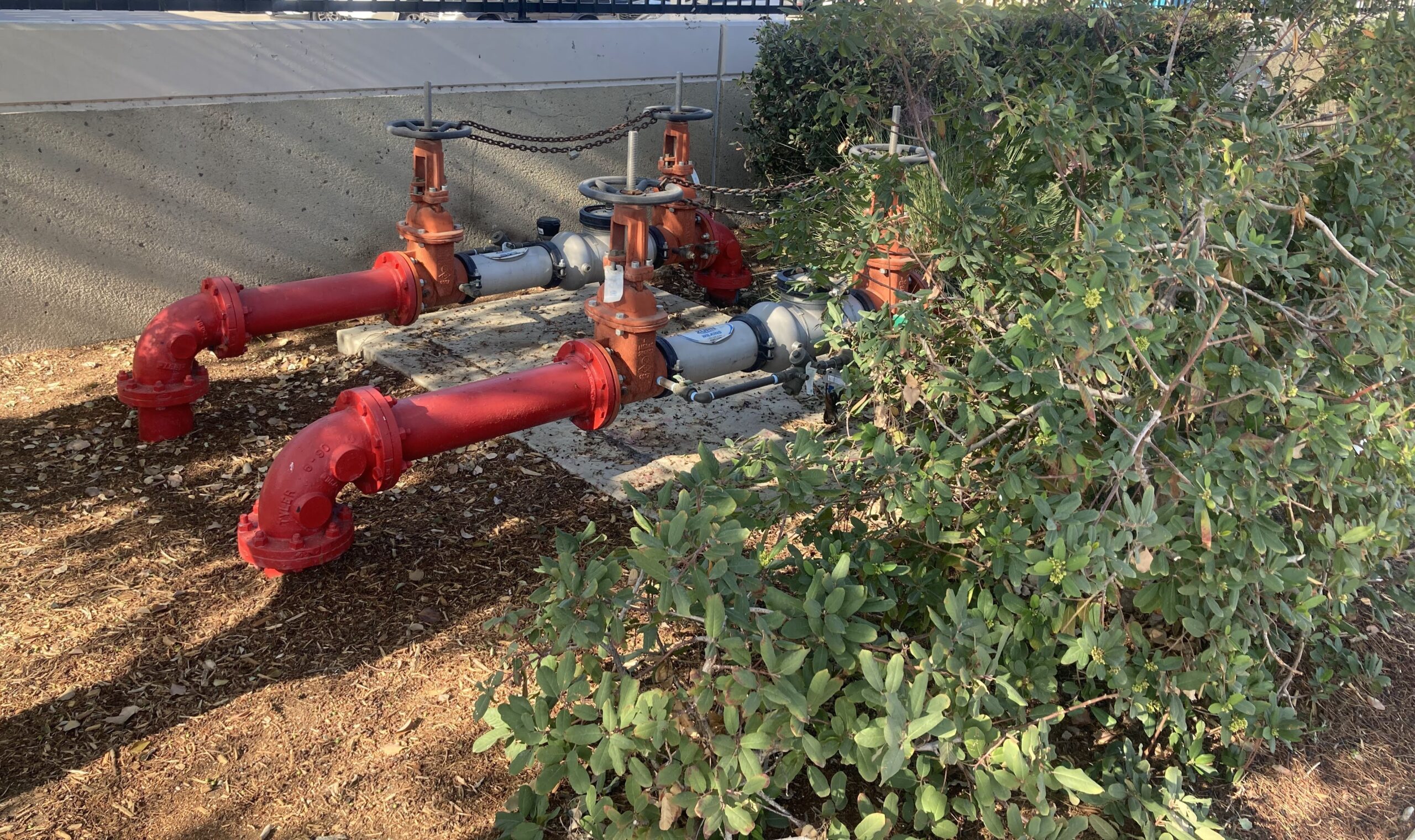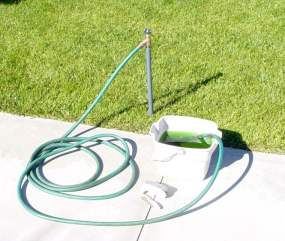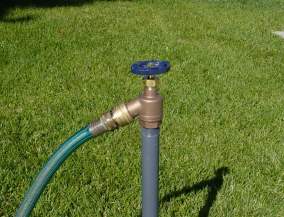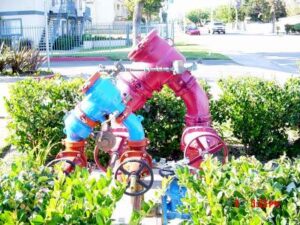EVMWD customers expect high quality water that is pure and healthful. Water purveyors spend millions of dollars to purify and treat water before it is delivered to consumers. However, many consumers are not aware that District personnel work diligently to protect potable water from pollution and contamination as it flows through the distribution system.
Cross-Connections and Backflow Prevention
Cross-Connections and Backflow Prevention
Unprotected cross-connections can pollute or contaminate potable water on a customer’s property or the distribution system from backflow. Examples of cross-connections are a water supply line connected to equipment containing a non-potable (unfit to drink) substance, or the end of a hose submerged in a bucket containing cleaning solution (photo).
Using a garden hose without backflow prevention can pollute or contaminate a water system from backsiphonage.
Backflow is a reversal in the normal flow of water within a potable water system. Water systems are designed to allow water to flow in one direction from sources, such as a treatment plant or well, to the points of use. Examples of points of use are landscape irrigation system, hose spigot, sink faucet, or toilet.
One cause of backflow is backsiphonage. Under certain circumstances, there can be an unexpected loss of system pressure in the distribution system. For example, a water main break or firefighting operation can lower distribution system pressure and cause the normal flow of water to reverse. Another cause of backflow is backpressure. Backpressure occurs when higher water pressure overcomes normal system pressure. Backpressure can result from a booster pump, interconnected water well, or pressure washing equipment. Backpressure or backsiphonage can cause backflow and pollute or contaminate the customer’s water system and public water system.
There are many possible situations that can create backflow. The important point is that without a properly functioning backflow prevention device, water can unexpectedly reverse in flow, drawing with it any undesirable materials from the points of use into the drinking water system.
The Importance of Prevention
Water has many domestic, agricultural, commercial, and industrial uses. Anywhere water is used, it may be mixed with undesirable materials. For example, landscape irrigation water me be contaminated with fertilizer or animal wastes. Commercial and industrial process water may be mixed either intentionally or inadvertently with chemicals or foreign materials.
Backflow prevention devices located immediately after the meter are required on all new commercial, industrial, and landscaping water services. District personnel conduct routine surveys of all existing commercial, industrial and agricultural services to assure that connections and uses are properly protected from cross-connection and backflow. Additionally, residential properties are occasionally surveyed for compliance with backflow prevention requirements.
Backflow Prevention Devices
Anywhere there is a potential for contamination or pollution of the drinking water system, a backflow prevention device is required. Devices can be small and simple, such as an anti-siphon vacuum breaker (AVB) on a hose spigot (photo), or large and complex, like those used on fire sprinkler systems (photo).
Backflow prevention devices used to protect the distribution system must be installed immediately after the water meter. These devices are owned and maintained by the customer or property owner. Installation of a backflow prevention device immediately after the water meter is often required on agricultural, landscape, commercial or industrial water services. This device only protects the water distribution system. Most of these types of services have a reduced pressure principle (RPP) assembly (photo). This type of device is installed above ground and has the necessary test connections to determine if each part of the device is operating correctly. It is important to note that the test valves on a backflow prevention device are only to be used by authorized personnel for testing the device. Connections to the test valves defeat the purpose of the backflow prevention device, and could damage it.

There are other types of devices to protect the water distribution system or on-site potable system. The type of device to be installed to protect the potable water system is determined based on water use and backflow potential. Types of backflow prevention devices are listed below:
- Air Gap
- Reduced Pressure Principal (RPP) Assembly
- Hose Bib or Irrigation System Atmospheric Vacuum Breaker (AVB)
- Double Check (DC)
- Dual Check
- Pressure Vacuum Breaker (PVB)
- Spill-Resistant Vacuum Breaker (SVB)
Backflow Prevention Program
Health agencies, water purveyors, contractors, and customers each have an important role in preventing unprotected cross-connections and backflow.
Federal and State law requires water suppliers to protect their water systems from contamination and pollution. Under the California Code of Regulations (CCR), all water purveyors must have a Cross-Connection Control Program. To view these regulations, please visit the website listed below, choose California Code of Regulations, and search for cross-connection control program.
Regulations and requirements for cross-connection control and backflow prevention in CCR Title 17 are found here.
As part of EVMWD’s cross-connection program, District cross-connection control specialists routinely conduct surveys of new and existing facilities to determine which type of backflow prevention is necessary to protect the water system.
EVMWD must assure that the distribution system is protected from contamination and pollution from backflow. If backflow prevention is required at the water meter, these devices must be tested initially and annually to assure they are operating correctly. In our area, tests and maintenance of backflow prevention devices must be conducted by County of Riverside Department of Environmental Health certified testers. For customer convenience, EVMWD maintains a list of testers with contact information. This list is included in the notification when annual testing is due, and is also available under Backflow Documents at the end of this section.
Certified testers are responsible for performing accurate tests, and repairing or replacing devices that fail. Additionally, testers must report all repairs and test results to EVMWD. After the testing is complete, the tester should give a copy of the test report to the customer and send the original report to EVMWD Backflow Prevention and Cross-Connection Control.
Plumbers, landscapers and other contractors are required to follow the latest publication of the Uniform Plumbing Code (UPC) regarding backflow and cross-connection prevention. Customers should contact state licensed contractors for modifications to their plumbing.
EVMWD considers any water that passes through the water meter as “used.” This is because EVMWD has lost control of the quality. After this point, the responsibility for preventing contamination and pollution of the drinking water system rests with the property owner or customer.
Backflow Prevention Device Test and Certification
Annually, thousands to millions of gallons of water can pass through a backflow prevention device. Devices can be subjected to summer heat and freezing winter cold. Water chemistry can affect the performance of a device. For example, water that is even slightly hard can form deposits on moving parts. Small debris, such as sand particles can foul check valves and prevent moving parts from operating correctly. Additionally, moving water does wear on components over time. For these reasons, backflow prevention devices must be tested and maintained to assure they will work properly.
The backflow prevention device test only takes a few minutes. The test assures that each part of the device is operating correctly. If the device fails the first test, the tester must investigate the reasons for the failure, and if necessary, repairs must be made. Often, cleaning will correct the problem. To maintain proper protection, devices that fail the initial test must be repaired and re-tested within 15 days.
Customers who have questions regarding the annual notices they receive can call our Water Protection Department at (951) 674-3146 x8401, or e-mail backflow@evmwd.net.
Definitions
Potable Water: Potable (POE-tuh-bull) water is water that does not contain objectionable pollution, contamination, minerals, or infective agents and is considered satisfactory for drinking and other domestic purposes.
Pollution: An impairment of the quality of the water to a degree which does not create a hazard to the public health but which does adversely and unreasonable affect aesthetic qualities.
Contamination: An impairment of the quality of the water which creates an actual hazard to public health through poisoning or through the spread of disease by sewage, industrial fluids, waste, etc.
Distribution System: The water system begins with the source of water such as groundwater or surface water. Wells, pumps and treatment facilities are part of the water system which delivers water to the distribution system. The water distribution system consists of tanks and pipes which store and deliver treated water to customers.
Backsiphonage: The term “backsiphonage” shall mean a form of backflow due to a reduction in system pressure which causes a sub-atmospheric pressure to exist at a site in the water system.
Backpressure: The term “backpressure” means any elevation of pressure in the downstream piping system (by pump, elevation of piping, or steam and/or air pressure) above the supply pressure at the point of consideration which would cause, or tend to cause, a reversal of the normal direction of flow.
Backflow Documents:
Backflow Specification W-21A
Backflow Specification W-21B
Backflow Specification W-21C
List of Certified Backflow Testers
Backflow Test Report
Backflow Theft Prevention
Backflow Device Theft Prevention – Information Sheet
Backflows are found at commercial properties, parks, industrial centers, schools, and some residential homes that have an auxiliary water supply on the property. Especially during the fall months, backflow devices become targets for thieves looking to cash in on the brass and copper elements of a backflow device. Since backflow devices are the property owner’s responsibility for repair and replacement, EVMWD wants to assist you in preventing theft.
Steps to Deter Backflow Theft
- Paint your backflow device to decrease its scrap value.
- Stamp, label, or identify the metal with a recognizable code.
- Enclose the backflow device within a protective cage. The cage should be secured or mounted to the ground. To prevent theft, have the cage spot-welded to the bolts.
- Add a high-quality lock on the cage. A “hockey puck” style lock works best for cages without lock guards.
- Consider using a lock guard to protect locks from bolt cutter access.
- Post a visible warning sign near the device.
- Consider a plastic backflow device, which has considerably fewer brass components.
- Camouflage your backflow device within the natural landscape surroundings.
- Use a heavy-duty enclosure box for industrial or high-security facilities.
What to do if your device is stolen
Turn off the water supply valve upstream of the backflow device. Report theft to EVMWD at 951-674-3146 ext. 8305 and your local police or sheriff (non-emergency).
FAQs
What is a backflow device?
A backflow preventer is a copper or brass valve device installed on the water service line leading into commercial buildings, multi-family homes, and single-family homes.
Why do we need them?
Backflow is a reversal of undesired water flow that can enter a water distribution system. A backflow device protects potable (drinking) water supplies from contamination or pollution due to backflow.
Why are backflow preventers stolen?
These devices are stolen for their brass and copper fixtures. The scrap metal value is approximately $60 per unit. New or replacement units can cost more than $850.
Who requires them?
Federal, State, and City codes require water suppliers to protect their water systems from contamination.
Follow these steps to stop backflow device theft
Step 1: Paint, Label or Coat
Paint your backflow preventer blue to decrease its scrap value. Stamp, label or identify the metal with a recognizable code.
Step 2: Cover/Enclose
Enclose the backflow preventer within a protective cage. The cage should be secured or mounted to the ground.
Step 3: Secure
Put a high-quality lock on the cage or use a lock guard to protect locks from bolt cutter access. A heavy-duty locking enclosure can also prevent theft.
Step 4: Post Warnings
Post a visible warning sign mentioning security and prosecution.
Step 5: Consider Plastic Options
A plastic backflow preventer is considered less valuable for thieves due to the minimal amount of brass.
Step 6: Hide/Conceal
You can disguise your backflow preventer by covering it or grouping it with other natural surroundings. For industrial or high-security facilities, use a heavy-duty enclosure box.




